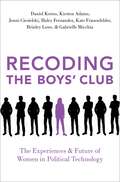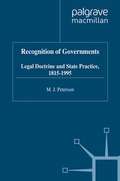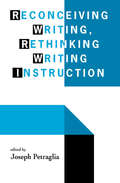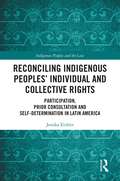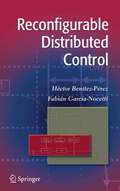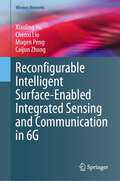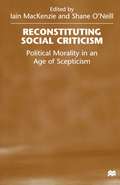- Table View
- List View
Reclaiming Fair Use: How to Put Balance Back in Copyright, Second Edition
by Patricia Aufderheide Peter JasziIn the increasingly complex and combative arena of copyright in the digital age, record companies sue college students over peer-to-peer music sharing, YouTube removes home movies because of a song playing in the background, and filmmakers are denied a distribution deal when a permissions i proves undottable. Analyzing the dampening effect that copyright law can have on scholarship and creativity, Patricia Aufderheide and Peter Jaszi urge us to embrace in response a principle embedded in copyright law itself—fair use. Originally published in 2011, Reclaiming Fair Use challenged the widely held notion that copyright law is obsolete in an age of digital technologies. Beginning with a survey of the contemporary landscape of copyright law, Aufderheide and Jaszi drew on their years of experience advising documentary filmmakers, English teachers, performing arts scholars, and other creative professionals to lay out in detail how the principles of fair-use can be employed to avoid copyright violation. Taking stock of the vibrant remix culture that has only burgeoned since the book’s original publication, this new edition addresses the expanded reach of fair use—tracking the Twitter hashtag #WTFU (where’s the fair use?), the maturing of the transformativeness measure in legal disputes, the ongoing fight against automatic detection software, and the progress and delays of digitization initiatives around the country. Full of no-nonsense advice and practical examples, Reclaiming Fair Use remains essential reading for anyone interested in law, creativity, and the ever-broadening realm of new media.
Reclaiming Fair Use: How to Put Balance Back in Copyright, Second Edition
by Patricia Aufderheide Peter JasziIn the increasingly complex and combative arena of copyright in the digital age, record companies sue college students over peer-to-peer music sharing, YouTube removes home movies because of a song playing in the background, and filmmakers are denied a distribution deal when a permissions i proves undottable. Analyzing the dampening effect that copyright law can have on scholarship and creativity, Patricia Aufderheide and Peter Jaszi urge us to embrace in response a principle embedded in copyright law itself—fair use. Originally published in 2011, Reclaiming Fair Use challenged the widely held notion that copyright law is obsolete in an age of digital technologies. Beginning with a survey of the contemporary landscape of copyright law, Aufderheide and Jaszi drew on their years of experience advising documentary filmmakers, English teachers, performing arts scholars, and other creative professionals to lay out in detail how the principles of fair-use can be employed to avoid copyright violation. Taking stock of the vibrant remix culture that has only burgeoned since the book’s original publication, this new edition addresses the expanded reach of fair use—tracking the Twitter hashtag #WTFU (where’s the fair use?), the maturing of the transformativeness measure in legal disputes, the ongoing fight against automatic detection software, and the progress and delays of digitization initiatives around the country. Full of no-nonsense advice and practical examples, Reclaiming Fair Use remains essential reading for anyone interested in law, creativity, and the ever-broadening realm of new media.
Reclaiming Fair Use: How to Put Balance Back in Copyright, Second Edition
by Patricia Aufderheide Peter JasziIn the increasingly complex and combative arena of copyright in the digital age, record companies sue college students over peer-to-peer music sharing, YouTube removes home movies because of a song playing in the background, and filmmakers are denied a distribution deal when a permissions i proves undottable. Analyzing the dampening effect that copyright law can have on scholarship and creativity, Patricia Aufderheide and Peter Jaszi urge us to embrace in response a principle embedded in copyright law itself—fair use. Originally published in 2011, Reclaiming Fair Use challenged the widely held notion that copyright law is obsolete in an age of digital technologies. Beginning with a survey of the contemporary landscape of copyright law, Aufderheide and Jaszi drew on their years of experience advising documentary filmmakers, English teachers, performing arts scholars, and other creative professionals to lay out in detail how the principles of fair-use can be employed to avoid copyright violation. Taking stock of the vibrant remix culture that has only burgeoned since the book’s original publication, this new edition addresses the expanded reach of fair use—tracking the Twitter hashtag #WTFU (where’s the fair use?), the maturing of the transformativeness measure in legal disputes, the ongoing fight against automatic detection software, and the progress and delays of digitization initiatives around the country. Full of no-nonsense advice and practical examples, Reclaiming Fair Use remains essential reading for anyone interested in law, creativity, and the ever-broadening realm of new media.
Reclaiming Fair Use: How to Put Balance Back in Copyright, Second Edition
by Patricia Aufderheide Peter JasziIn the increasingly complex and combative arena of copyright in the digital age, record companies sue college students over peer-to-peer music sharing, YouTube removes home movies because of a song playing in the background, and filmmakers are denied a distribution deal when a permissions i proves undottable. Analyzing the dampening effect that copyright law can have on scholarship and creativity, Patricia Aufderheide and Peter Jaszi urge us to embrace in response a principle embedded in copyright law itself—fair use. Originally published in 2011, Reclaiming Fair Use challenged the widely held notion that copyright law is obsolete in an age of digital technologies. Beginning with a survey of the contemporary landscape of copyright law, Aufderheide and Jaszi drew on their years of experience advising documentary filmmakers, English teachers, performing arts scholars, and other creative professionals to lay out in detail how the principles of fair-use can be employed to avoid copyright violation. Taking stock of the vibrant remix culture that has only burgeoned since the book’s original publication, this new edition addresses the expanded reach of fair use—tracking the Twitter hashtag #WTFU (where’s the fair use?), the maturing of the transformativeness measure in legal disputes, the ongoing fight against automatic detection software, and the progress and delays of digitization initiatives around the country. Full of no-nonsense advice and practical examples, Reclaiming Fair Use remains essential reading for anyone interested in law, creativity, and the ever-broadening realm of new media.
Recoding the Boys' Club: The Experiences and Future of Women in Political Technology
by Daniel Kreiss Kirsten Adams Jenni Ciesielski Haley Fernandez Kate Frauenfelder Brinley Lowe Gabrielle MicchiaThe #MeToo movement has catalyzed an international discussion about the routine challenges women face in their professional lives as a result of male-dominated industries and office cultures. These include well-documented cases of sexual harassment and assault, but also unequal opportunities, unequal pay, sexist stereotypes, and a devaluation of women's labor. While these are problems women face in all industries and at all levels, the political and technology sectors are particularly rife with them. Recoding the Boys' Club is a ground-breaking deep-dive into the work experiences of women in the political technology field in the United States. Political technology sits at the intersection of two fields dominated by men--politics and technology--and has become a cornerstone of operations in political campaigns and political institutions more generally. Drawing on a unique dataset of 1004 staffers working in political technology on presidential campaigns from 2004-2016, analysis of hiring patterns during the 2020 presidential primary cycle, and interviews with 45 women who worked on 12 different presidential campaigns, this book reveals the underrepresentation of women in political technology, especially leadership positions, as well as the struggle women face to have their voices heard within the "boys' clubs" and "bro cultures" of political technology. It chronicles the gendered expectations women face to provide emotional labor, stereotypes about women's competencies that shape their opportunities, the ways in which women's ideas are discredited, and the formal and informal forms of exclusion in campaign culture--leading to widespread feelings of "imposter syndrome" among women in this environment. These issues are often compounded by a mentality that the well-being of staffers must come secondary to the goals of the campaign, despite what campaigns might profess publically about gender and labor. Since these campaigns are important entry and training points for the wider field of political technology, the gendered inequities encountered within them have implications for women's professional experiences and careers long after campaigns have ended. This book aims to help political practitioners create more gender equitable and inclusive workplaces, ones that value the ideas and skills of all those who work to get candidates elected.
RECODING THE BOYS' CLUB OSDP C: The Experiences and Future of Women in Political Technology
by Kirsten Adams Daniel Kreiss Jenni Ciesielski Haley Fernandez Kate Frauenfelder Brinley Lowe Gabrielle MicchiaThe #MeToo movement has catalyzed an international discussion about the routine challenges women face in their professional lives as a result of male-dominated industries and office cultures. These include well-documented cases of sexual harassment and assault, but also unequal opportunities, unequal pay, sexist stereotypes, and a devaluation of women's labor. While these are problems women face in all industries and at all levels, the political and technology sectors are particularly rife with them. Recoding the Boys' Club is a ground-breaking deep-dive into the work experiences of women in the political technology field in the United States. Political technology sits at the intersection of two fields dominated by men--politics and technology--and has become a cornerstone of operations in political campaigns and political institutions more generally. Drawing on a unique dataset of 1004 staffers working in political technology on presidential campaigns from 2004-2016, analysis of hiring patterns during the 2020 presidential primary cycle, and interviews with 45 women who worked on 12 different presidential campaigns, this book reveals the underrepresentation of women in political technology, especially leadership positions, as well as the struggle women face to have their voices heard within the "boys' clubs" and "bro cultures" of political technology. It chronicles the gendered expectations women face to provide emotional labor, stereotypes about women's competencies that shape their opportunities, the ways in which women's ideas are discredited, and the formal and informal forms of exclusion in campaign culture--leading to widespread feelings of "imposter syndrome" among women in this environment. These issues are often compounded by a mentality that the well-being of staffers must come secondary to the goals of the campaign, despite what campaigns might profess publically about gender and labor. Since these campaigns are important entry and training points for the wider field of political technology, the gendered inequities encountered within them have implications for women's professional experiences and careers long after campaigns have ended. This book aims to help political practitioners create more gender equitable and inclusive workplaces, ones that value the ideas and skills of all those who work to get candidates elected.
Recognition of Governments: Legal Doctrine and State Practice, 1815-1995 (Studies in Diplomacy)
by M. PetersonProvides a systematic comparison of legal scholars' views and governments' practice regarding the occasions for, criteria for, and effects of recognition. It traces the evolution from the 19th century practice basing recognition mainly on effective rule to more frequent use of additional criteria in the interwar and early Cold War, to the reassertion of the primacy of effective rule since 1970 and places it in the context of contemporaneous changes in world politics.
Reconceiving Writing, Rethinking Writing Instruction
by Joseph PetragliaTo a degree unknown in practically any other discipline, the pedagogical space afforded composition is the institutional engine that makes possible all other theoretical and research efforts in the field of rhetoric and writing. But composition has recently come under attack from many within the field as fundamentally misguided. Some of these critics have been labelled "New Abolitionists" for their insistence that compulsory first-year writing should be abandoned. Not limiting itself to first-year writing courses, this book extends and modifies calls for abolition by taking a closer look at current theoretical and empirical understandings of what contributors call "general writing skills instruction" (GWSI): the curriculum which an overwhelming majority of writing instructors is paid to teach, that practically every composition textbook is written to support, and the instruction for which English departments are given resources to deliver. The vulnerability of GWSI is hardly a secret among writing professionals and its intellectual fragility has been felt for years and manifested in several ways: * in persistently low status of composition as a study both within and outside of English departments; * in professional journal articles and conference presentations that are growing both in theoretical sophistication and irrelevance to the composition classroom; and * in the rhetoric and writing field's ever-increasing attention to nontraditional sites of writing behavior. But, to date, there has been relatively little concerted discussion within the writing field that focuses specifically on the fundamentally awkward relationship of writing theory and writing instruction. This volume is the first to explicitly focus on the gap in the theory and practice that has emerged as a result of the field's growing professionalization. The essays anthologized offer critiques of GWSI in light of the discipline's growing understanding of the contexts for writing and their rhetorical nature. Writing from a wide range of cognitivist, critical-theoretical, historical, linguistic and philosophical perspectives, contributors call into serious question basic tenets of contemporary writing instruction and provide a forum for articulating a sort of zeitgeist that seems to permeate many writing conferences, but which has, until recently, not found a voice or a name.
Reconceiving Writing, Rethinking Writing Instruction
by Joseph PetragliaTo a degree unknown in practically any other discipline, the pedagogical space afforded composition is the institutional engine that makes possible all other theoretical and research efforts in the field of rhetoric and writing. But composition has recently come under attack from many within the field as fundamentally misguided. Some of these critics have been labelled "New Abolitionists" for their insistence that compulsory first-year writing should be abandoned. Not limiting itself to first-year writing courses, this book extends and modifies calls for abolition by taking a closer look at current theoretical and empirical understandings of what contributors call "general writing skills instruction" (GWSI): the curriculum which an overwhelming majority of writing instructors is paid to teach, that practically every composition textbook is written to support, and the instruction for which English departments are given resources to deliver. The vulnerability of GWSI is hardly a secret among writing professionals and its intellectual fragility has been felt for years and manifested in several ways: * in persistently low status of composition as a study both within and outside of English departments; * in professional journal articles and conference presentations that are growing both in theoretical sophistication and irrelevance to the composition classroom; and * in the rhetoric and writing field's ever-increasing attention to nontraditional sites of writing behavior. But, to date, there has been relatively little concerted discussion within the writing field that focuses specifically on the fundamentally awkward relationship of writing theory and writing instruction. This volume is the first to explicitly focus on the gap in the theory and practice that has emerged as a result of the field's growing professionalization. The essays anthologized offer critiques of GWSI in light of the discipline's growing understanding of the contexts for writing and their rhetorical nature. Writing from a wide range of cognitivist, critical-theoretical, historical, linguistic and philosophical perspectives, contributors call into serious question basic tenets of contemporary writing instruction and provide a forum for articulating a sort of zeitgeist that seems to permeate many writing conferences, but which has, until recently, not found a voice or a name.
Reconciling Indigenous Peoples’ Individual and Collective Rights: Participation, Prior Consultation and Self-Determination in Latin America (Indigenous Peoples and the Law)
by Jessika EichlerThis book critically assesses categorical divisions between indigenous individual and collective rights regimes embedded in the foundations of international human rights law. Both conceptual ambiguities and practice-related difficulties arising in vernacularisation processes point to the need of deeper reflection. Internal power struggles, vulnerabilities and intra-group inequalities go unnoticed in that context, leaving persisting forms of neo-colonialism, neo-liberalism and patriarchalism largely untouched. This is to the detriment of groups within indigenous communities such as women, the elderly or young people, alongside intergenerational rights representing considerable intersectional claims and agendas. Integrating legal theoretical, political, socio-legal and anthropological perspectives, this book disentangles indigenous rights frameworks in the particular case of peremptory norms whenever these reflect both individual and collective rights dimensions. Further-reaching conclusions are drawn for groups ‘in between’, different formations of minority groups demanding rights on their own terms. Particular absolute norms provide insights into such interplay transcending individual and collective frameworks. As one of the founding constitutive elements of indigenous collective frameworks, indigenous peoples’ right to prior consultation exemplifies what we could describe as exerting a cumulative, spill-over and transcending effect. Related debates concerning participation and self-determination thereby gain salience in a complex web of players and interests at stake. Self-determination thereby assumes yet another dimension, namely as an umbrella tool of resistance enabling indigenous cosmovisions to materialise in the light of persisting patterns of epistemological oppression. Using a theoretical approach to close the supposed gap between indigenous rights frameworks informed by empirical insights from Bolivia, the Andes and Latin America, the book sheds light on developments in the African and European human rights systems.
Reconciling Indigenous Peoples’ Individual and Collective Rights: Participation, Prior Consultation and Self-Determination in Latin America (Indigenous Peoples and the Law)
by Jessika EichlerThis book critically assesses categorical divisions between indigenous individual and collective rights regimes embedded in the foundations of international human rights law. Both conceptual ambiguities and practice-related difficulties arising in vernacularisation processes point to the need of deeper reflection. Internal power struggles, vulnerabilities and intra-group inequalities go unnoticed in that context, leaving persisting forms of neo-colonialism, neo-liberalism and patriarchalism largely untouched. This is to the detriment of groups within indigenous communities such as women, the elderly or young people, alongside intergenerational rights representing considerable intersectional claims and agendas. Integrating legal theoretical, political, socio-legal and anthropological perspectives, this book disentangles indigenous rights frameworks in the particular case of peremptory norms whenever these reflect both individual and collective rights dimensions. Further-reaching conclusions are drawn for groups ‘in between’, different formations of minority groups demanding rights on their own terms. Particular absolute norms provide insights into such interplay transcending individual and collective frameworks. As one of the founding constitutive elements of indigenous collective frameworks, indigenous peoples’ right to prior consultation exemplifies what we could describe as exerting a cumulative, spill-over and transcending effect. Related debates concerning participation and self-determination thereby gain salience in a complex web of players and interests at stake. Self-determination thereby assumes yet another dimension, namely as an umbrella tool of resistance enabling indigenous cosmovisions to materialise in the light of persisting patterns of epistemological oppression. Using a theoretical approach to close the supposed gap between indigenous rights frameworks informed by empirical insights from Bolivia, the Andes and Latin America, the book sheds light on developments in the African and European human rights systems.
Reconfigurable Active and Passive Planar Antennas for Wireless Communication Systems (Signals and Communication Technology)
by Shiban Kishen Koul Rajesh K. SinghThis book presents state-of-the-art trends in reconfigurable active and passive planar antennas and their applications in wireless communication systems operating in the frequency band 5-6 GHz. Due to various key features such as multifunction antenna design, compactness, planar nature, and low cost, these technologies are becoming popular for current and future wireless applications. This book discusses different novel antenna designs and their working principles in detail. The modern and future wireless systems require wideband antennas to accommodate various channels in a single band or in separate bands. The carrier aggregation (CA) has been introduced in the modern wireless systems such as LTE-advanced systems and 5G./6G. In CA, a device can use several channels for transmission and reception. The used channels can exist in the same frequency band (intra-band CA) or in distinct bands (inter-band CA). To accommodate more channels, more bandwidth is required within the operating band. For portable devices, circularly polarized (CP) antennas are more advantageous over linearly polarized antennas since in CP antennas, there is low risk of misalignment and, hence encountering interference. Circularly polarized antenna also provides higher link reliability for the portable devices. To provide high data rates, more bandwidth is needed to accommodate more channels. Various multifunction, compact, and wideband antennas for plethora of applications are addressed in detail in this book. The scope of developing reconfigurable active antennas for application in beam switching, beam steering, wireless charging, security systems, etc., is described. This book concludes by giving glimpses of antenna requirements for future wireless communication systems.
Reconfigurable Cryptographic Processor
by Leibo Liu Bo Wang Shaojun WeiThis book focuses on the design methods for reconfigurable computing processors for cryptographic algorithms. It covers the dynamic reconfiguration analysis of cryptographic algorithms, hardware architecture design, and compilation techniques for reconfigurable cryptographic processors, and also presents a case study of implementing the reconfigurable cryptographic processor “Anole” designed by the authors’ team. Moreover, it features discussions on countermeasures against physical attacks utilizing partially and dynamically reconfigurable array architecture to enhance security, as well as the latest trends for reconfigurable cryptographic processors. This book is intended for research scientists, graduate students, and engineers in electronic science and technology, cryptography, network and information security, as well as computer science and technology.
Reconfigurable Distributed Control
by hector benitez Fabián García-NocettiThis informative monograph helps meet the challenge of applying distributed control to dynamical systems. It shows readers how to bring the best parts of various control paradigms to bear in making distributed control more flexible and responsive.
Reconfigurable Intelligent Surface-Empowered 6G (Wireless Networks)
by Hongliang Zhang Boya Di Lingyang Song Zhu HanThis book presents novel RIS-Based Smart Radio techniques, targeting at achieving high-quality channel links in cellular communications via design and optimization of the RIS construction. Unlike traditional antenna arrays, three unique characteristics of the RIS will be revealed in this book. First, the built-in programmable configuration of the RIS enables analog beamforming inherently without extra hardware or signal processing. Second, the incident signals can be controlled to partly reflect and partly transmit through the RIS simultaneously, adding more flexibility to signal transmission. Third, the RIS has no digital processing capability to actively send signals nor any radio frequency (RF) components. As such, it is necessary to develop novel channel estimation and communication protocols, design joint digital and RIS-based analog beamforming schemes and perform interference control via mixed reflection and transmission. This book also investigates how to integrate the RIS to legacy communication systems. RIS techniques are further investigated in this book (benefited from its ability to actively shape the propagation environment) to achieve two types of wireless applications, i.e., RF sensing and localization. The influence of the sensing objectives on the wireless signal propagation can be potentially recognized by the receivers, which are then utilized to identify the objectives in RF sensing. Unlike traditional sensing techniques, RIS-aided sensing can actively customize the wireless channels and generate a favorable massive number of independent paths interacting with the sensing objectives. It is desirable to design RIS-based sensing algorithms, and optimize RIS configurations. For the second application, i.e., RIS aided localization, an RIS is deployed between the access point (AP) and users. The AP can then analyze reflected signals from users via different RIS configurations to obtain accurate locations of users. However, this is a challenging task due to the dynamic user topology, as well as the mutual influence between multiple users and the RIS. Therefore, the operations of the RIS, the AP, and multiple users need to be carefully coordinated. A new RIS-based localization protocol for device cooperation and an RIS configuration optimization algorithm are also required. This book targets researchers and graduate-level students focusing on communications and networks. Signal processing engineers, computer and information scientists, applied mathematicians and statisticians, who work in RIS research and development will also find this book useful.
Reconfigurable Intelligent Surface-Enabled Integrated Sensing and Communication in 6G (Wireless Networks)
by Xiaoling Hu Chenxi Liu Mugen Peng Caijun ZhongAs the main trend and key enabling technology for next-generation wireless networks (i.e., 6G), integrated sensing and communication (ISAC) can effectively improve spectrum efficiency, hardware efficiency, and information processing efficiency. However, it faces several deficiencies, including limited coverage due to high-frequency signals and limited communication-sensing performance due to uncontrollable wireless environments. Reconfigurable intelligent surface (RIS) provides novel dimensions to address these deficiencies by intelligently manipulating the wireless propagation environment in an energy- and hardware-efficient manner. RIS-enabled ISAC is expected to comprehensively promote the multi-dimensional performance of 6G, such as communication capacity, sensing accuracy, and coverage. Nevertheless, to fully realize its potential, one needs to figure out the impacts of RIS on joint communication and sensing performance and tackle new technical challenges in beamforming design and signal processing. The goal of this book, therefore, is to deliver a thorough understanding of RIS-enabled ISAC from three perspectives: performance analysis, beamforming design, and signal processing. Specifically, the authors provide a brief introduction to RIS-enabled ISAC, including basic concepts, motivations, potential application scenarios, and an overview of the state-of-the-art research on RIS-enabled ISAC. The theoretical performance analytical frameworks of RIS-enabled ISAC and their corresponding results are also discussed. Based on this, several critical issues are identified and elaborated on, including signal processing technologies such as angle and Delay-Doppler information acquisition, and air interface technologies such as beamforming designs. Finally, the book concludes with future trends and open issues for further research.The book would be beneficial for researchers, graduate students, and industry professionals who wish to gain a comprehensive understanding of the latest developments and challenges in RIS-enabled ISAC. By providing insights into the potential of RIS-enabled ISAC and the technical challenges that need to be addressed, the book can aid in the development of practical solutions for next-generation wireless networks and contribute to the advancement of the field of wireless communications.
Reconstituting Social Criticism: Political Morality in an Age of Scepticism
by Shane O'Neill Iain MacKenzieIn the context of a new global order where the logic of the market reigns virtually unopposed, there is a clear need for original thinking that might reinvigorate a progressive political project. This collection of essays brings together the work of a number of leading scholars who are concerned to construct a convincing basis for incisive criticism today. These contributors represent the most vibrant and influential of contemporary critical perspectives: egalitarian liberalism, socialism, poststructuralism, psychoanalysis, hermeneutics and critical theory.
Reconstructing Communicating: Looking To A Future (Routledge Communication Series)
by Robyn PenmanIn this innovative and potentially controversial book, Penman examines the future of communication as a discipline. She foresees a time in which communicating is conceived as a social construction process, in the anticipation that this will allow a genuine practical response to contemporary social problems. The book sets out a map toward accomplishing that future--laying the foundations for a different way of conceiving of communication, enabling direct action, rather than just theorizing about it. It begins with a history illustrating how the communication discipline has arrived to where it is today and then goes on to demonstrate Penman's conception of communication. Reconstructing Communicating is an exploration of what it means to inquire into communicating; to treat communicating as the essential problematic of concern; and to recognize that we construct our reality in our communicating. In undertaking this exploration, the author pursues a central theme of what constitutes good communicating and good communication research. Arguments throughout this book provide a radical departure from mainstream communication studies and especially from the rationalist's quest for truth and scientific knowledge. A way of acting in good faith is offered, both with the process of communicating and with the participants in it, that generates practical understandings for constructing new futures. Designed for communication scholars and graduate students primarily in organizational communication, public relations, and communication theory, this book will also interest those in management and business as it deals with practical communication issues.
Reconstructing Communicating: Looking To A Future (Routledge Communication Series)
by Robyn PenmanIn this innovative and potentially controversial book, Penman examines the future of communication as a discipline. She foresees a time in which communicating is conceived as a social construction process, in the anticipation that this will allow a genuine practical response to contemporary social problems. The book sets out a map toward accomplishing that future--laying the foundations for a different way of conceiving of communication, enabling direct action, rather than just theorizing about it. It begins with a history illustrating how the communication discipline has arrived to where it is today and then goes on to demonstrate Penman's conception of communication. Reconstructing Communicating is an exploration of what it means to inquire into communicating; to treat communicating as the essential problematic of concern; and to recognize that we construct our reality in our communicating. In undertaking this exploration, the author pursues a central theme of what constitutes good communicating and good communication research. Arguments throughout this book provide a radical departure from mainstream communication studies and especially from the rationalist's quest for truth and scientific knowledge. A way of acting in good faith is offered, both with the process of communicating and with the participants in it, that generates practical understandings for constructing new futures. Designed for communication scholars and graduate students primarily in organizational communication, public relations, and communication theory, this book will also interest those in management and business as it deals with practical communication issues.
Reconstructing Relationships In Higher Education: Challenging Agendas (PDF)
by Celia Whitchurch George GordonDrawing on two international research projects, Reconstructing Relationships in Higher Education: Challenging Agendas looks behind formal organisational structures and workforce patterns to consider the significance of relationships, particularly at local and informal levels, for the aspirations and motivations of academic faculty. In practice, and day-to-day, such relationships can overlay formal reporting lines and therefore inform, to a greater or lesser extent, the overall relationship between individuals and institutions. As a result, from an institutional point of view, relationships may be a critical factor in the realisation of strategy, and can in practice have a disproportionate effect, both positively and negatively. However, little attention has been paid to the role that they play in understanding the interface between individuals and institutions at a time of ongoing diversification of the workforce. For instance, they may provide space, which in turn may be implicit and discretionary, in which negotiation and influence can occur. In this context, Reconstructing Relationships in Higher Education also reviews ways in which institutions are responding to more agentic approaches by academic faculty, particularly younger cohorts, and the significance of local managers, mentors and academic networks in supporting individuals and promoting career development. The text, which examines the dynamics of working relationships at local and institutional level, will be of interest to senior management teams, practising managers at all levels, academic faculty, and researchers in the field of higher education.
The Reconstruction of Modality in Chinese-English Government Press Conference Interpreting: A Corpus-Based Study (Corpora and Intercultural Studies #1)
by Xin LiThis book investigates a special genre of interpreting in the Chinese context, namely Government Press Conference (GPC) Interpreting. Drawing on the modality system from Systemic Functional Grammar and a corpus of 21 interpreting events, the project explores the regular patterns of modality shifts in Chinese-English GPC interpreting and seeks explanations in the sociocultural context. As a corpus-based project, the book covers qualitative analysis of the sociocultural context, qualitative analysis of the interpersonal effects of modality shifts, and quantitative analysis of modality shifts. This book will contribute to the understanding of the distinctive features of GPC interpreting in China, shed new light on the rendition of modality between Chinese and English in specific contexts, and also inspire new thoughts on the nature of interpreting in general.
The Reconstruction of Space and Time: Mobile Communication Practices
by Rich LingOne of the most significant and obvious examples of how mobile communication influences our understanding of time and space is how we coordinate with one another. Mobile communication enables us to call specific individuals, not general places. Regardless of location, we are able to make contact with almost anyone, almost anywhere. This advancement has changed, and continues to change, human interaction. Now, instead of agreeing on a particular time well beforehand, we can iteratively work out the most convenient time and place to meet at the last possible moment--on the way to the meeting or once we arrive at the destination.In their early days, mobile devices were primarily used for various types of emergency situations and for work. In some cases, the device was an essential element in various business operations or used so that overseas workers could communicate with their families. The distance between a remote posting and the people back home was suddenly and dramatically reduced. People began to share these devices not necessarily out of economic issues, but also questions of family and interpersonal dynamics.The process of sharing decisions as to who is a legitimate partner makes the nature of relationships more explicit. By examining the economy of sharing, we not only see how sharing mobile phones restructures social space, but are also given insight into an individual's web of interactions. This cutting-edge book deals with modern ways of thinking about communication and human interaction; it will illuminate the ways in which mobile communication alters our experience with space and time.
The Reconstruction of Space and Time: Mobile Communication Practices
by Rich LingOne of the most significant and obvious examples of how mobile communication influences our understanding of time and space is how we coordinate with one another. Mobile communication enables us to call specific individuals, not general places. Regardless of location, we are able to make contact with almost anyone, almost anywhere. This advancement has changed, and continues to change, human interaction. Now, instead of agreeing on a particular time well beforehand, we can iteratively work out the most convenient time and place to meet at the last possible moment--on the way to the meeting or once we arrive at the destination.In their early days, mobile devices were primarily used for various types of emergency situations and for work. In some cases, the device was an essential element in various business operations or used so that overseas workers could communicate with their families. The distance between a remote posting and the people back home was suddenly and dramatically reduced. People began to share these devices not necessarily out of economic issues, but also questions of family and interpersonal dynamics.The process of sharing decisions as to who is a legitimate partner makes the nature of relationships more explicit. By examining the economy of sharing, we not only see how sharing mobile phones restructures social space, but are also given insight into an individual's web of interactions. This cutting-edge book deals with modern ways of thinking about communication and human interaction; it will illuminate the ways in which mobile communication alters our experience with space and time.
Record, Mix and Master: A Beginner’s Guide to Audio Production
by Simon DuggalThis textbook is a practical guide to achieving professional-level audio productions using digital audio workstations. It contains 27 chapters divided into three sections, with specially devised diagrams and audio examples throughout. Aimed at students of all levels of experience and written in an easy-to-understand way, this book simplifies complex jargon, widening its appeal to non-academic creatives and is designed to accelerate the learning of professional audio processes and tools (software and hardware).The reader can work through the book from beginning to end or dip into a relevant section whenever required, enabling it to serve as both a step by step guide and an ongoing reference manual. The book is also a useful aid for lecturers and teachers of audio production, recording, mixing and mastering engineering.
Recovering Overlooked Pragmatists in Communication: Extending the Living Conversation about Pragmatism and Rhetoric
by Robert DanischThis collection of essays engages with the current resurgence of interest in the relationship between American pragmatism and communication studies. The topics engaged in this collection of essays is necessarily diverse, with some of the figures discussed within often viewed as “minor” or ancillary to the main tradition of pragmatism. However, each essay attempts to show the value of reading these minor figures for philosophy and rhetorical studies. The diversity of the pragmatist tradition is evident in the ways in which unlikely figures like Hu Shi, Ambedkar, and Alice Dewey leverage some of the original commitments of pragmatism to do important intellectual, social, and political work within the circumstances that they find themselves. This collection of essays also serves as a reminder for how we might reimagine and reuse pragmatism for our own social and political projects and challenges.

